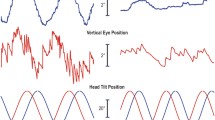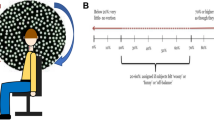Summary
The vertical and horizontal components of the vestibulo-ocular reflex (VOR) were recorded in alert, restrained cats who were placed on their sides and subjected to whole-body rotations in the horizontal plane. The head was either on the axis or 45 cm eccentric from the axis of rotation. During off-axis rotation there was a change in the linear force acting on the otolith organs due to the presence of a centripetal acceleration along the animal's vertical axis. Otolith forces (defined to be opposite to the centripetal acceleration) directed ventrally with respect to the animal (negative) decreased both the amplitude and time constant of the first-order approximation to the slow phase eye velocity of the vertical vestibulo-ocular reflex (VVOR). Otolith forces directed dorsally (positive) increased the amplitude and time constant. The effects were greater for the up VOR. The asymmetry in the VVOR time constant also depended on the otolith forces, being less in the presence of negative otolith forces that caused the resultant otolith force to move ventrally, towards the direction along which gravity normally acts when the animal is in the upright position. The effects of otolith forces on the up VVOR were independent of whether the animals were tested in the dark or in the light with a stationary visual surround (i.e., during visual suppression). In contrast, the changes in the time constant of the down VVOR were smaller during visual suppression. Simulations of the eye velocity storage mechanism suggest that the gain of the feedback in the storage integrator was modified by the angle between the resultant otolith force and an animal-fixed reference. This could be the animal's vertical, i.e., the direction along which gravity normally acts. For larger angles the feedback was less and the amplitude and time constant of the VVOR increased. The transformation of the otolith input was the same for both the up and down VOR, even though the final effect on the eye velocity was asymmetric (larger for up VOR) due to a separate, asymmetric gain element in the velocity storage feedback pathway.
Similar content being viewed by others
References
Anastasio TJ, Correia MJ (1988) A frequency and time domain study of the horizontal and vertical vestibulo-ocular reflex in the pigeon. J Neurophysiol 59:1143–1161
Angelaki DE, Anderson JH, Blakley BW (1989) Effect of linear acceleration on the vertical VOR and visual suppression. Soc Neurosci Abstr 15:514
Angelaki DE, Anderson JH (1991) The horizontal vestibulo-ocular reflex during linear acceleration in the frontal plane of the cat. Exp Brain Res 86:40–46
Anderson JH, Liston SL (1985) Asymmetry of vestibulo-ocular reflex in the cat. Otolaryng Head Neck Surg 93:597–600
Baarsma EA, Collewijin H (1975) Eye movements due to linear acceleration in the rabbit. J Neurophysiol 245:227–249
Baloh RW, Beykirch K, Honrubia V, Yee RD (1988) Eye movements induced by linear acceleration on a parallel swing. J Neurophysiol 60:2000–2013
Baloh RW, Honrubia V, Yee RD, Jacobson K (1986) Vertical visual-vestibular interaction in normal human subjects. Exp Brain Res 64:400–406
Baloh RW, Richman L, Yee RD, Honrubia V (1983) The dynamics of vertical eye movements in normal human subjects. Aviat Space Environ Med 54:32–38
Blakley B, Anderson JH (1986) Changes in the time constant of the vestibulo-ocular reflex due to otolith stimulation. Soc Neurosci Abstr 12:252
Blanks RHI, Estes MS, Markham CH (1975) Physiological characteristics of vestibular first order canal neurons in the cat. II. Response to constant angular acceleration. J Neurophysiol 38:1250–1267
Bodin MA (1968) The effect of gravity on human vestibular responses during rotation in pitch. J Physiol 196:74P-75P
Bohmer A, Henn V (1983) Horizontal and vertical vestibulo-ocular and cervico-ocular reflex in the monkey during high frequency rotation. Brain Res 277:241–248
Calhoun KH, LeLiever WC, Correia MJ (1982) Effects of position change on optokinetic nystagmus and optokinetic afternystagmus in man. Otolaryng Head Neck Surg 91:81–84
Clement G, Vieville T, Lestienne F, Berthoz A (1986) Modification of gain asymmetry and beating field of vertical optokinetic nystagmus in microgravity. Neurosci Lett 63:271–274
Collins WE, Schroeder DJ, Rice N, Mertens RA, Kranz G (1970) Some characteristics of optokinetic eye movement patterns: a comparative study. Aerosp Med 41:1251–1262
Correia MJ, Money KE (1970) The effect of blockage of all six semicircular canal ducts on nystagmus produced by dynamic linear acceleration in the cat. Acta Otolaryng 69:7–16
Correia MJ, Perachio AA, Eden AR (1985) The monkey vertical vestibular response: a frequency domain study. J Neurophysiol 54:532–548
Darlot C, Lopez-Barneo J, Tracey D (1981) Asymmetries of vertical vestibular nystagmus in the cat. Exp Brain Res 41:420–426
Fuchs AF, Kimm J (1975) Unit activity in vestibular nucleus of the alert monkey during horizontal angular acceleration and eye movement. J Neurophysiol 38:1140–1161
Hain TC (1986) A model of the nystagmus induced by off vertical axis rotation. Biol Cybern 54:337–350
Hess BJM, Knopfel T, Precht W (1984) Dynamics of maculo-ocular reflexes in the frog. Neurosci 11:645–650
Hine T, Thorn F (1987) Compensatory eye movements during active head rotation for near targets: effects of imagination, rapid head oscillation and vergence. Vision Res 27:1639–1657
Judge SJ, Richmond BJ, Chu FC (1980) Implantation of magnetic search coils for measurement of eye position: an improved method. Vis Res 20:535–538
Keller EL, Precht W (1979) Visual-vestibular responses in vestibular nuclear neurons in intact and cerebellectomized, alert cat. Neuroscience 4:1599–1613
King WM, Leigh RJ (1982) Physiology of vertical gaze. In: Lennerstrand G, Zee DS, Keller EL (eds) Functional basis of ocular motility disorders. Pergamon, New York, pp 267–276
Leigh RJ, Robinson DA, Zee DS (1981) A hypothetical explanation for periodic alternating nystagmus: instability in the optokinetic-vestibular system. Ann NY Acad Sci 374:619–635
LeLiever WC, Correia MJ (1987) Further observations on the effects of head position on vertical OKN and OKAN in normal subjects. Otolaryng Head Neck Surg 97:275–281
Magnin M, Salinger W, Kennedy H (1986) Optokinetic response and visual suppression of the vestibulo-ocular reflex in the open loop condition in the cat. Vision Res 26:653–660
Maioli C, Precht W, Ried S (1983) Short and long-term modifications of vestibulo-ocular response dynamics following unilateral vestibular nerve lesions in the cat. Exp Brain Res 50:259–274
Marmarelis PZ, Marmarelis VZ (1978) Analysis of physiological systems. The white noise approach. Plenum Press, New York, pp 51–61
Matsuo V, Cohen B (1984) Vertical optokinetic nystagmus and vestibular nystagmus in the monkey: up-down asymmetry and effects of gravity. Exp Brain Res 53:197–216
Matsuo V, Cohen B, Raphan T, Dejong V, Henn V (1979) Asymmetric velocity storage for upward and downward nystagmus. Brain Res 176:159–164
Money KE, Scott JW (1962) Functions of separate sensory receptors of nonauditory labyrinth of the cat. Am J Physiol 202:1211–1220
Morrison DF (1967) Multivariate statistical methods. McGrawHill, New York
Nelder JA, Mead R (1965) A simplex method for function minimization. Computer J 7:308–313
Paige GD (1983) Vestibuloocular reflex and its interactions with visual following mechanisms in the squirrel monkey. I. Response characteristics in normal animals. J Neurophysiol 49:134–151
Raphan T, Cohen B, Matsuo V (1977) A velocity storage mechanism responsible for optokinetic nystagmus (OKN), optokinetic after-nystagmus (OKAN) and vestibular nystagmus. In: Baker R, Berthoz A (eds) Control of gaze by brain stem neurons: developments in neuroscience. Elsevier/North-Holland, New York, pp 37–47
Raphan T, Cohen B (1988) Organization principles of velocity storage in three dimensions. The effect of gravity on crosscoupling of optokinetic after-nystagmus. Ann NY Acad Sci 545:74–92
Raphan T, Schnabolk C (1988) Modeling slow phase velocity generation during off-vertical axis rotation. Ann NY Acad Sci 545:29–50
Robinson DA (1963) A method of measuring eye movement using a scleral search-coil in a magnetic field. IEEE Trans Biomed Eng 10:137–145
Robinson DA (1981) The use of control system analysis in the neurophysiology of eye movements. Ann Rev Neurosci 4:463–503
Tomko DL, Paige GD (1988) Linear vestibulo-ocular reflex (LVOR) of the squirrel monkey. I. Basic characteristics. Soc Neurosci Abstr 14:332
Tomko DL, Wall C, Robinson FR, Staab JP (1988) Influence of gravity on cat vertical vestibulo-ocular reflex. Exp Brain Res 69:307–314
Wall C, Black FO (1981) An algorithm for the clinical analysis of nystagmus eye movements. IEEE Trans Biomed Eng 28:638–646
Young LR, Henn VS (1975) Nystagmus produced by pitch and yaw rotation in monkeys about non-vertical axes. Fortschr Zool 23:235–246
Author information
Authors and Affiliations
Rights and permissions
About this article
Cite this article
Angelaki, D.E., Anderson, J.H. & Blakley, B.W. Changes in the dynamics of the vertical vestibulo-ocular reflex due to linear acceleration in the frontal plane of the cat. Exp Brain Res 86, 27–39 (1991). https://doi.org/10.1007/BF00231037
Received:
Accepted:
Issue Date:
DOI: https://doi.org/10.1007/BF00231037




